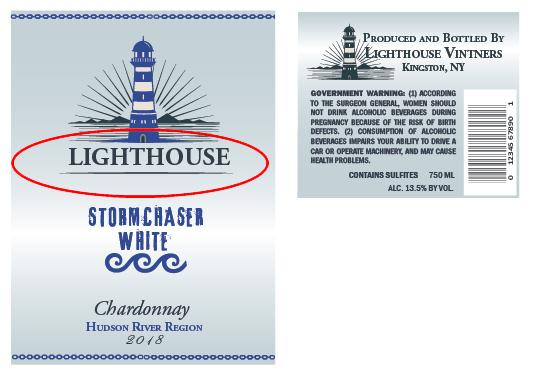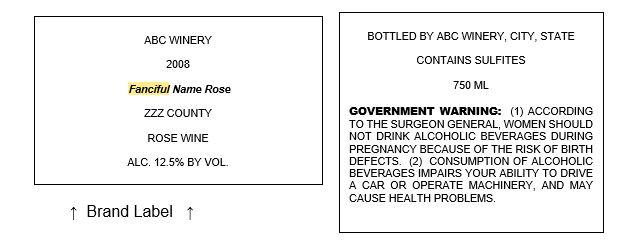A brand name is the name under which a wine or line of wines is marketed. It is usually the most prominent information on the label. If the wine is not sold under a brand name, the name of the bottler, packer, or importer will be treated as the brand name if it is shown on the designated brand label.
The brand name may not create a misleading impression.

In this example, the brand name is “Lighthouse.” The fanciful name
(which is optional for a wine label) in this example is “Stormchaser White.”
Where should the brand name be placed on the product?
The brand name must appear on the designated brand label.
What are the formatting requirements for the brand name?
Type size:
- Minimum 2 mm for containers larger than 187 mL;
- Minimum 1 mm for containers of 187 mL or less.
Note: The minimum type size applies to each numeral or letter in the statement, including both upper-case and lower-case letters.
Legibility:
- Must be readily legible under ordinary conditions;
- Must appear on a contrasting background; and
- Must appear separate and apart from, or be substantially more conspicuous than, descriptive or explanatory information.
When is a brand name misleading?
A brand name is misleading if, whether standing alone or in combination with other printed or graphic material, it creates a misleading or erroneous impression or inference as to the age, origin, identity or other characteristics of the wine. No label may include a misleading brand name.
In some instances, qualifying the brand name with the word “brand” may be appropriate so that the brand name conveys no erroneous impression as to the age, origin, identity, or other characteristics of the product. TTB will make these determinations on a case-by-case basis. Please note that qualification with the word “brand” is not an option in the case of a brand name of viticultural significance.
What is a brand name of viticultural significance?
A brand name has viticultural significance if the brand name includes the name of:
- A U.S. State or foreign equivalent;
- A U.S. county or foreign equivalent;
- An approved American or foreign viticultural area; or
- A geographic area that is found to have viticultural significance by TTB, including the terms of viticultural significance included with certain American Viticultural Areas (AVAs) in 27 CFR part 9.
What rules apply to brand names of viticultural significance?
A brand name of viticultural significance may not be used unless:
- The wine meets the appellation of origin requirements for the geographic area named;
OR
- The brand name is “grandfathered” by use on an existing certificate of label approval (COLA) issued prior to July 7, 1986, and meets the requirements for use in 27 CFR 4.39(i).
Qualification with the word “brand” is not an option in the case of a brand name of viticultural significance.
May I use the name of a vineyard, orchard, farm, or ranch in my brand name?
When used in a brand name, a vineyard, orchard, farm, or ranch name having geographical or viticultural significance is subject to the requirements of 27 CFR 4.33(b) and 4.39(i).
In general, a brand name that includes a vineyard, orchard, farm, or ranch name is acceptable:
- If not less than 95 percent of the wine was produced from primary winemaking material grown on the named vineyard, orchard, farm, or ranch;
OR
- If the company name or trade name shown in the mandatory name and address statement on the label is identical to the brand name that includes a vineyard, orchard, farm, or ranch name.
What is the difference between a brand name and a fanciful name?
As stated above, a brand name is the name under which a wine or line of wines is marketed. It is usually the most prominent information on the label. A brand name is required to appear on the brand label of every wine.
A fanciful name is a descriptive name or phrase chosen to further identify a product and may be used in addition to a brand name on a product label. (Some industry members may also refer to this as a “sell name.”) A fanciful name is not required for wine, regardless of whether it bears a statement of composition. For additional information, see Class and/or Type Designations.
Fanciful names, like other optional information on labels, may not create a false or misleading impression about the wine.
Note: If you choose to use a fanciful name on your wine, it is not a substitute for a brand name, class or type designation, or (if required) an appellation of origin or a statement of composition on a wine product.

The brand name in this example is “ABC Winery” and “Fanciful Name Rose” is the fanciful name.
Fanciful names do not replace the need for a class and type designation (in this case, “Rose Wine”).
“Rose” (like “red,” “pink” “amber,” or “white”) must be followed by “Wine” in order to serve as the class and type designation.
Page last reviewed: March 2, 2013
Page last updated: September 23, 2019
Maintained by: Alcohol Labeling and Formulation Division

